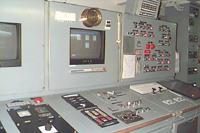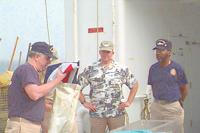| |
Teacher
Logbook:
Monday, July 31, 2000
Mary Beth's Observations
Yesterday Carol and I had the opportunity to tour the massive, and very
clean, engine room, responsible for generating all the power and potable
water for NOAA Ship Ronald H. Brown. The ship is powered by a state of
the art split bus diesel electric propulsion system. The ship's stern
thrusters can rotate 360 degrees to provide exceptional control and maneuverability.
The ship's engine room also contains 6 diesel generators, which provide
power to the propulsion system. The generators also supply power to all
the ship's laboratories, vans, communications and navigation systems,
as well as to dynamic positioning, scientific information and machinery
control systems throughout the ship.
I was amazed by the amount
of electronic equipment found in the engine room. All engine room operations
are controlled by a central computer (see attached picture). We soon discovered
the ship could be driven from the engine room using the same computer
controls found on the bridge. In am emergency, the ship could also be
driven manually, with individual controlling the directions of the thrusters
using hydraulics.
Let's take a minute to
recognize the guys who work so hard to keep the ship moving in the right
direction. Chief Marine Engineer Steven Layn First
Assistant Engineer Michael Gowen
Second Assistant Engineer Michael Kelsey
Third Assistant Engineer Brian Mitchell
Junior Engineer Gordon Gardipe
Junior Engineer Patrick McManus
Wiper Patrick Quinanola
They work to ensure the
engines are running, the engine room is clean and we all have water to
drink each day we are on the ship.
Carol's
Observations
Sunday was a special day for the Teachers-At-Sea. We took a short break
from our duties and eagerly awaited the evening's outdoor cookout, which
the early morning fog couldn't dampen. The fog didn't clear most of the
day. It clung to the ship's cold walls, changed to a thin sheet of water,
and collected on the decks. Not the kind of day for an "iron beach" picnic.
I lost all hope that the weather would clear in time. The sun finally
heated the air enough for the fog to clear an hour before the big event.
The party was a great success. The traditional hot dogs, hamburgers and
ribs with all the fixings were spread out on long tables. For dessert
there were two ice cream layer cakes. The birthday cake was for Darin's
sixteenth birthday. Darin is one of the Broward County Marine Science
students on this cruise. The going away cake was for Daniel Aronson, LCDR,
USPHS. Dan is the ship's "Doc" and taking his last cruise with NOAA ship
Ronald H. Brown before his reassignment to Norfolk, VA.
Even with a party going
on the scientific research continued. Those responsible for running the
ship and taking CTD data ate in shifts. Scientists, officers and crew
at sea do not take a day off. Data collection occurs around the clock
seven days a week as the ship sails the planned course. In the past, my
students at Jamestown High School (JHS) had e-mailed the scientists with
questions. The scientists, in-spite of a very busy schedule, replied promptly
and completely to the JHS students. Being on this cruise has made me keenly
aware of how little we knew about the scientists' long work hours and
the challenges of conducting research for weeks at a time at sea.
|
|

The centraol computer control panel in the Brown's engine room.

The Doc opening some of
his going-away presents as this is his farewell voyage on the Brown.
|
|

